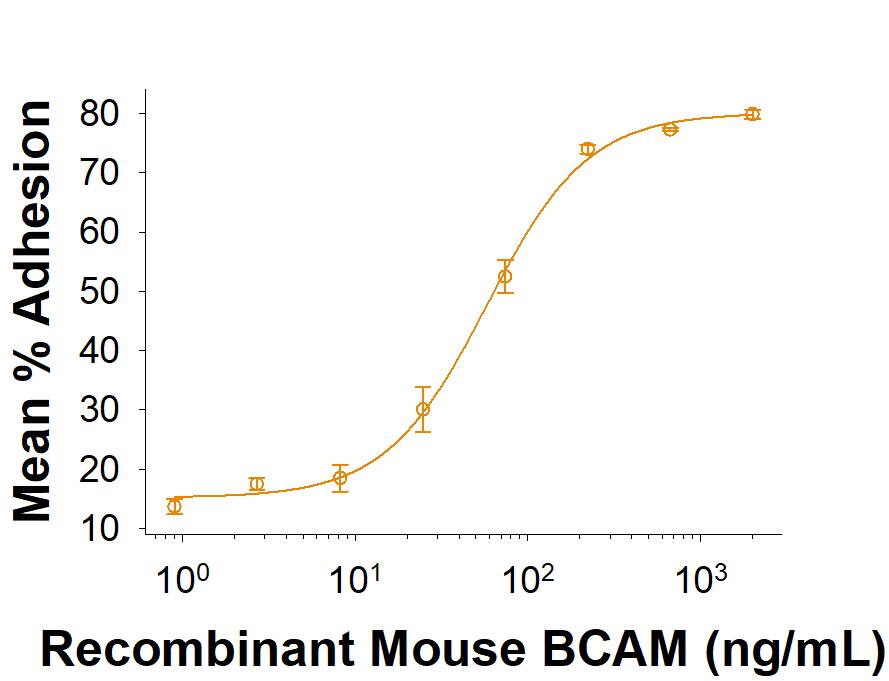Recombinant Mouse BCAM His-tag Protein, CF
R&D Systems, part of Bio-Techne | Catalog # 11174-BC

Key Product Details
Product Specifications
Source
Mouse myeloma cell line, NS0-derived mouse BCAM protein
Glu26-Ala541, with a C-terminal 6-His tag
Glu26-Ala541, with a C-terminal 6-His tag
Purity
>95%, by SDS-PAGE visualized with Silver Staining and quantitative densitometry by Coomassie® Blue Staining.
Endotoxin Level
<0.10 EU per 1 μg of the protein by the LAL method.
N-terminal Sequence Analysis
Glu26
Predicted Molecular Mass
58 kDa
SDS-PAGE
65-85 kDa, under reducing conditions.
Activity
Measured by the ability of the immobilized protein to support the adhesion of TE-85 human osteogenic sarcoma cells.
The ED50 for this effect is 18.0-162 ng/mL.
The ED50 for this effect is 18.0-162 ng/mL.
Scientific Data Images for Recombinant Mouse BCAM His-tag Protein, CF
Recombinant Mouse BCAM His-tag Protein Bioactivity.
Recombinant Mouse BCAM His-tag Protein (Catalog # 11174-BC) supports the adhesion of TE‑85 human osteogenic sarcoma cells. The ED50 for this effect is 18.0-162 ng/mL.Recombinant Mouse BCAM His-tag Protein SDS-PAGE.
2 μg/lane of Recombinant Mouse BCAM His-tag Protein (Catalog # 11174-BC) was resolved with SDS-PAGE under reducing (R) and non-reducing (NR) conditions and visualized by Coomassie® Blue staining, showing bands at 65-85 kDa.Formulation, Preparation and Storage
11174-BC
| Formulation | Lyophilized from a 0.2 μm filtered solution in PBS with Trehalose. |
| Reconstitution | Reconstitute at 500 μg/mL in PBS. |
| Shipping | The product is shipped at ambient temperature. Upon receipt, store it immediately at the temperature recommended below. |
| Stability & Storage | Use a manual defrost freezer and avoid repeated freeze-thaw cycles.
|
Background: BCAM
References
- Rahuel, C. et al. (1999) Immunogenetics 50:271.
- Garin-Chesa, P. et al. (1994) Int. J. Oncol. 5:1261.
- Schon, M. et al. (2000) J. Invest. Dermatol. 115:1047.
- Rahuel, C. et al. (2008) Am. J. Physiol. Renal Physiol. 294:F393.
- Rettig, W.J. et al. (1986) Cancer Res. 46:6406.
- Rettig, W.J. et al. (1988) Proc. Natl. Acad. Sci. 85:3110.
- Nishimune, H. et al. (2008) J. Cell Biol. 182:1201.
- Kikkawa, Y. et al. (2007) J. Biol. Chem. 282:14853.
- Vainionpaa, N. et al. (2006) Am. J. Physiol. Cell. Physiol. 290:C764.
- Zen, Q. et al. (1999) J. Biol. Chem. 274:728.
- Wautier, M.-P. et al. (2007) Blood 110:894.
- Udani, M. et al. (1998) J. Clin. Invest. 101:2550.
- Chaar, V. et al. (2010) Haematologica 95:1841.
- Gauthier, E. et al. (2009) Br. J. Haematol. 148:456.
Long Name
Basal Cell Adhesion Molecule
Alternate Names
CD239
Gene Symbol
BCAM
UniProt
Additional BCAM Products
Product Documents for Recombinant Mouse BCAM His-tag Protein, CF
Product Specific Notices for Recombinant Mouse BCAM His-tag Protein, CF
For research use only
